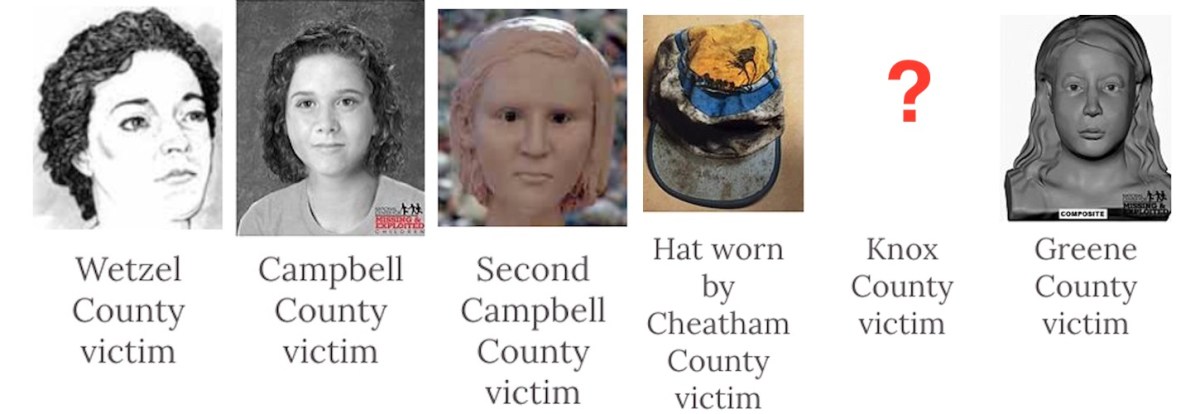Since the time of Jack the Ripper women without roots, abandoned by family, or rejected somehow have been favorite targets for predators. Sex workers or transient women, just looking for a way to get by, a safe place to land.
Nancy Lynn Blankenship was a redheaded 20-year-old when she vanished in 1983 from her home in rural Lavinia, Tennessee. She’d just learned she was pregnant. Christmas was less than a week away.
On the day she disappeared Nancy made brownies, wrote Christmas cards, and fed her puppy, Bocephus. Then she was gone. A neighbor saw an unfamiliar white car at the house Nancy shared with husband Ken the day of the disappearance, but that was nearly the only lead investigators had. For 11 years, no one knew what had happened to her.
She was found in the Tennessee River in 1994. Her bones showed evidence of injury to her throat and—oddly—that she’d only been in the water for five years.
Nancy’s pregnancy might point to a domestic cause for her death. Suspicion reportedly did at first fall on her husband. However, not long after Nancy disappeared, another possibility came to light: Perhaps she’d fallen prey to a serial killer.
A killer with a taste for red-haired women.
As Bob Lewis wrote in the February 10, 1985 edition of the Jackson Sun, law enforcement in three states—Arkansas, Mississippi, and Tennessee—said “the same killer could be responsible for strangling three red-haired women found in their states.” And federal authorities, Lewis wrote, hoped these murders would “provide leads in the disappearance of” Nancy Blankenship.
The possibility some killer targeted red-haired women across the south from the late 1970s through the early 90s is a nearly-forgotten mystery today. It may be that law enforcement ultimately rejected the idea that one killer was involved.
Then again, it could be the public perception of the mostly unknown victims led to disinterest in the case—a bias in some members of the media and in law enforcement that these women had led lives that could only naturally end at the hands of a predator.
In her self-published ebook The Redhead Murders, author Jane Carlisle notes the killer—if indeed there was just one—“wanted to find girls and women who weren’t going to have anybody come looking for them.” Nancy Lynn Blankenship was one of the few with a name and an apparently normal home life—if she was a victim of the killer at all.
According to the ’85 report in the Sun, there were enough matching elements in these murders—in addition to natural or dyed red hair—to make any investigator take notice. They’d been strangled. They were partially clothed. They’d been dumped along Interstates crisscrossing the south.
Carlisle writes that the first victim was found in February 1983 “by a pair of senior citizens” in Wetzel County, Virginia. There was snow on the ground but only a frosting on her body. The victim wasn’t raped, but she was asphyxiated. She could have been as old as 45 and there was evidence she’d had a Caesarean section. This victim was well-groomed, likely not homeless.
Lisa Nichols may have been victim no. 2. The 28-year-old woman’s body was found on I-40 in September 1984, not far from West Memphis, Arkansas. Nichols was from West Virginia but police weren’t able to find her family—a couple she’d stayed with in Florida identified her in June 1985. Nichols’s body wasn’t far from a truck stop; police believed she’d been hitchhiking.
Possible redhead victim number three was found by I-75 not far from Jellico, Tennessee on New Year’s Day, 1985. She was no older than 25 and clothed. She was a few months pregnant when she was killed. Another victim was found just four months later in the same county, but she’d been dead too long to determine hair color.
In March of 1985 the severely decomposed body of a redheaded woman was found in Cheatham County, Tennessee, west of Nashville. She was found on I-24. She was clothed and possibly as old as 40 when she died.
Police made a particularly grim and strange discovery the next day in Knox County, Kentucky. Inside a white refrigerator with a Super Woman decal on the door was the nude body of a petite woman 24 to 35 years of age, clad only in mismatched socks and wearing a pair of necklaces. She, too, had once had a Caesarian, and she was pregnant when she was killed.
Just a few weeks later another young woman with light-colored hair and red highlights was found in Greene County, Tennessee. She may have been as young as 14—and she’d had a recent miscarriage.
The Redhead Murders as well as a Wiki on the case list several more possible victims, mostly Jane Does, and at least three suspects. Police ultimately concluded none of the men were connected to the crimes.
The last significant report to mention the Redhead Murders may have undercut the theory of its existence. On June 30, 1992 the AP reported a nun named Vickie Sue Metzger had been found close to a rest stop on I-24. Someone had strangled the redheaded woman then buried her under leaves and sticks on Tennessee’s Monteagle Mountain. Dr. Charles Harlan, the Tennessee state medical examiner at the time, said her death bore similarities to the Redhead Murders. Law enforcement officials like Indiana State Police official Robert Abbitt weren’t buying it. “Sure there are similarities in many different cases,” Abbitt told the AP, “and we look at the similarities.”
But, Abbitt continued, “we won’t do that until we have something to solidly link it together.”
Abbitt’s skepticism in the case was proven right when a rest stop employee named John Allen Chapman was arrested for the murder of Metzger and a convenience store clerk. In 1997 he was sentenced to life without parole in prison, and no one’s ever linked him to other redhead murders. And Charles Harlan, the medical examiner who proposed the link? In 2005, he was stripped of his medical license due to incompetence.
In addition to hair color, there were undeniable commonalities in the Redhead Murders: Pregnancies, choices of location. They occurred over a discrete period—approximately 12 years—in the same general geographic region. The victims fit a certain age range. As for why ginger women were targeted? It’s long been known that sometimes serial killers will focus on women with a certain appearance, as Ted Bundy seemed to with women who had long brown hair parted in the middle.
The threads that could conclusively tie the deaths of these redheaded women together may have been left dangling for far too long. They frayed between jurisdictions, got lost in differences in the depths of investigations. Maybe they were lost to sheer indifference as well.
This article appeared in an InsideHook newsletter. Sign up for free to get more on travel, wellness, style, drinking, and culture.
























